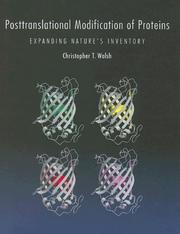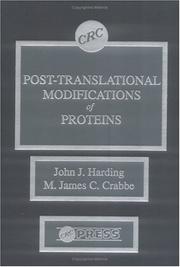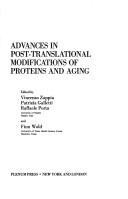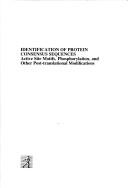| Listing 1 - 10 of 13 | << page >> |
Sort by
|

ISBN: 0974707732 Year: 2006 Publisher: Greenwood Village : Colorado : Roberts and company publishers,
Abstract | Keywords | Export | Availability | Bookmark
 Loading...
Loading...Choose an application
- Reference Manager
- EndNote
- RefWorks (Direct export to RefWorks)
Protein Processing, Post-Translational. --- Proteins --- metabolism.

ISBN: 084934171X Year: 1991 Publisher: Boca Raton Ann Arbor London CRC Press
Abstract | Keywords | Export | Availability | Bookmark
 Loading...
Loading...Choose an application
- Reference Manager
- EndNote
- RefWorks (Direct export to RefWorks)

ISBN: 0306428059 1468490443 1468490427 9780306428050 Year: 1988 Volume: 231 Publisher: New York London Plenum Press
Abstract | Keywords | Export | Availability | Bookmark
 Loading...
Loading...Choose an application
- Reference Manager
- EndNote
- RefWorks (Direct export to RefWorks)
Post-translational modification --- Aging --- Protein Processing, Post-Translational --- Congresses --- Physiological aspects --- physiology --- Congresses. --- Proteins --- Metabolism --- Post-translational modification - Congresses --- Aging - Physiological aspects - Congresses --- Protein Processing, Post-Translational - congresses --- Aging - physiology - congresses
Dissertation
Year: 1991 Publisher: Amsterdam Rodopi
Abstract | Keywords | Export | Availability | Bookmark
 Loading...
Loading...Choose an application
- Reference Manager
- EndNote
- RefWorks (Direct export to RefWorks)
DNA --- Glycoproteins --- Protein Processing, Post-Translational --- DNA --- Chromosomes, Human, Pair 3 --- Thrombosis --- RNA, Messenger --- metabolism --- genetics --- genetics --- genetics --- biosynthesis

ISBN: 0134540670 0745803768 Year: 1990 Publisher: Horwood
Abstract | Keywords | Export | Availability | Bookmark
 Loading...
Loading...Choose an application
- Reference Manager
- EndNote
- RefWorks (Direct export to RefWorks)
Amino Acid Sequence --- Biochemistry --- Consensus Sequence --- Protein Processing, Post-Translational --- Amino acid sequence --- Séquence des acides aminés --- physiology --- methods --- Technique --- Technique. --- Séquence des acides aminés --- physiology. --- methods.
Book
ISBN: 0199632731 019963274X 9780199632732 Year: 1992 Publisher: London Oxford university
Abstract | Keywords | Export | Availability | Bookmark
 Loading...
Loading...Choose an application
- Reference Manager
- EndNote
- RefWorks (Direct export to RefWorks)
Recent developments have revealed that proteins can undergo a diverse range of modifications by lipids which can dramatically effect their structural and functional properties. These modifications include acylation, isoprenylation, and the attachment of glycolipid. Written by acknowledged experts in the field, this unique guide describes the latest biochemical, cell biological, and molecular biological techniques being used in this rapidly expanding area. The book discusses lipid modifications of proteins which play important roles in cellular signalling, protein targeting and cellular growth and differentiation. Detailed protocols are provided for all the key techniques, and the relevant background material is included. The book will be an essential manual for a wide range of scientists studying the modification of protein by lipids, including membrane and protein biochemists, cell biologists, immunologists, bacteriologists, parasitologists, and virologists.
Analytical biochemistry --- Lipoproteins --- Protein Processing, Post-Translational --- Acylation --- Post-translational modification --- Protéines --- chemical synthesis --- Synthesis --- Research --- Methodology --- Modification post-traductionnelle --- Post-translational modification. --- Acylation. --- Methodology. --- Protéines --- Protein Processing, Post-Translational. --- chemical synthesis. --- Co-translational modification --- Cotranslational modification --- Modification, Post-translational --- Post-translation protein modification --- Post-translational protein modification --- Posttranslation protein modification --- Posttranslational modification --- Posttranslational protein modification --- Genetic translation --- Proteins --- Lipids --- Chemical reactions --- Synthesis&delete& --- Research&delete& --- Lipoproteins - Synthesis - Research - Methodology.

ISBN: 0121821560 0121821579 0121821587 9780121821562 9780121821586 9780121821579 Year: 1995 Volume: 255-256-257 Publisher: New York, NY : Academic Press,
Abstract | Keywords | Export | Availability | Bookmark
 Loading...
Loading...Choose an application
- Reference Manager
- EndNote
- RefWorks (Direct export to RefWorks)
G Proteins --- G Proteïnen --- Guanosine triphosphatase --- Guanosine-trifosfatase --- Guanosinetriphosphatase --- Proteins [G ] --- Proteïnen [G ] --- Protéines G --- Trifosfatase [Guanosine-] --- Triphosphatase [Guanosine] --- Physiological effect --- Protéines G monomériques --- GENE EXPRESSION --- RECOMBINANT PROTEINS --- PROTEIN PROCESSING, POST-TRANSLATIONAL --- TRANSLATION, GENETIC --- GUANINE NUCLEOTIDES --- CHEMICAL ACTIONS --- PREPARATION --- Gtp phosphohydrolases --- Gtp-binding proteins --- Oncogene protein p21(ras) --- Ras genes --- Guanine nucleotides
Book
ISBN: 0128119500 0128119136 9780128119501 9780128119136 Year: 2019 Publisher: London, United Kingdom : Academic Press, an imprint of Elsevier,
Abstract | Keywords | Export | Availability | Bookmark
 Loading...
Loading...Choose an application
- Reference Manager
- EndNote
- RefWorks (Direct export to RefWorks)
Protein Modificomics: From Modifications to Clinical Perspectives comprehensively deals with all of the most recent aspects of post-translational modification (PTM) of proteins, including discussions on diseases involving PTMs, such as Alzheimer's, Huntington's, X-linked spinal muscular atrophy-2, aneurysmal bone cyst, angelman syndrome and OFC10. The book also discusses the role PTMs play in plant physiology and the production of medicinally important primary and secondary metabolites. The understanding of PTMs in plants helps us enhance the production of these metabolites without greatly altering the genome, providing robust eukaryotic systems for the production and isolation of desired products without considerable downstream and isolation processes. Provides thorough insights into the posttranslational modifications (PTMs) of proteins in both the plant and animal kingdom. Presents diagrammatic representations of various protein modification and estimation mechanisms in four-colors. Includes coverage of diseases involving posttranslational modifications.--
Proteomics. --- Proteins. --- Protein Processing, Post-Translational. --- Amino Acid Modification, Posttranslational --- Post-Translational Amino Acid Modification --- Post-Translational Modifications --- Post-Translational Protein Processing --- Posttranslational Amino Acid Modification --- Posttranslational Modifications --- Posttranslational Protein Processing --- Protein Processing, Post Translational --- Protein Processing, Posttranslational --- Amino Acid Modification, Post-Translational --- Post-Translational Protein Modification --- Protein Modification, Post-Translational --- Amino Acid Modification, Post Translational --- Modification, Post-Translational --- Modification, Post-Translational Protein --- Modification, Posttranslational --- Modifications, Post-Translational --- Modifications, Post-Translational Protein --- Modifications, Posttranslational --- Post Translational Amino Acid Modification --- Post Translational Modifications --- Post Translational Protein Modification --- Post Translational Protein Processing --- Post-Translational Modification --- Post-Translational Protein Modifications --- Posttranslational Modification --- Processing, Post-Translational Protein --- Processing, Posttranslational Protein --- Protein Modification, Post Translational --- Protein Modifications, Post-Translational --- Glycosylation --- Histone Code --- Metabolic Detoxication, Phase II --- Proteids --- Biomolecules --- Polypeptides --- Proteomics --- Molecular biology --- Proteins --- Post Translational Modification
Book
ISBN: 9781493910106 1493910094 9781493910090 1493910108 Year: 2015 Publisher: New York, NY : Springer New York : Imprint: Springer,
Abstract | Keywords | Export | Availability | Bookmark
 Loading...
Loading...Choose an application
- Reference Manager
- EndNote
- RefWorks (Direct export to RefWorks)
Lasso peptides form a growing family of fascinating ribosomally-synthesized and post-translationally modified peptides produced by bacteria. They contain 15 to 24 residues and share a unique interlocked topology that involves an N-terminal 7 to 9-residue macrolactam ring where the C-terminal tail is threaded and irreversibly trapped. The ring results from the condensation of the N-terminal amino group with a side-chain carboxylate of a glutamate at position 8 or 9, or an aspartate at position 7, 8 or 9. The trapping of the tail involves bulky amino acids located in the tail below and above the ring and/or disulfide bridges connecting the ring and the tail. Lasso peptides are subdivided into three subtypes depending on the absence (class II) or presence of one (class III) or two (class I) disulfide bridges. The lasso topology results in highly compact structures that give to lasso peptides an extraordinary stability towards both protease degradation and denaturing conditions. Lasso peptides are generally receptor antagonists, enzyme inhibitors and/or antibacterial or antiviral (anti-HIV) agents. The lasso scaffold and the associated biological activities shown by lasso peptides on different key targets make them promising molecules with high therapeutic potential. Their application in drug design has been exemplified by the development of an integrin antagonist based on a lasso peptide scaffold. The biosynthesis machinery of lasso peptides is therefore of high biotechnological interest, especially since such highly compact and stable structures have to date revealed inaccessible by peptide synthesis. Lasso peptides are produced from a linear precursor LasA, which undergoes a maturation process involving several steps, in particular cleavage of the leader peptide and cyclization. The post-translational modifications are ensured by a dedicated enzymatic machinery, which is composed of an ATP-dependent cysteine protease (LasB) and a lactam synthetase (LasC) that form an enzymatic complex called lasso synthetase. Microcin J25, produced by Escherichia coli AY25, is the archetype of lasso peptides and the most extensively studied. To date only around forty lasso peptides have been isolated, but genome mining approaches have revealed that they are widely distributed among Proteobacteria and Actinobacteria, particularly in Streptomyces, making available a rich resource of novel lasso peptides and enzyme machineries towards lasso topologies.
Biomedicine. --- Medical Microbiology. --- Immunology. --- Vaccine. --- Medicine. --- Microbiology. --- Vaccines. --- Médecine --- Immunologie --- Microbiologie --- Vaccins --- Peptides --- Bacteria --- Protein Modification, Translational --- Complex Mixtures --- Proteins --- Biological Science Disciplines --- Amino Acids, Peptides, and Proteins --- Protein Biosynthesis --- Chemicals and Drugs --- Natural Science Disciplines --- Peptide Biosynthesis --- Disciplines and Occupations --- Biochemical Processes --- Biochemical Phenomena --- Chemical Phenomena --- Phenomena and Processes --- Bacterial Proteins --- Physiology --- Biological Products --- Protein Processing, Post-Translational --- Biology --- Health & Biological Sciences --- Microbiology & Immunology --- Structure --- Synthesis --- Physiological effect --- Peptide antibiotics. --- Antimicrobial peptides --- Medical microbiology. --- Antibiotics --- Biologicals --- Immunobiology --- Life sciences --- Serology --- Microbial biology --- Microorganisms
Book
ISSN: 00766879 ISBN: 0123851165 9780123851161 9780123851147 0123851149 9780123859280 012385928X 9786613164216 1283164213 0123859298 9786612994272 0123851173 1282994271 9786612994265 0123851157 1282994263 Year: 2011 Volume: v. 490 Publisher: San Diego, Calif. : Academic Press, an imprint of Elsevier,
Abstract | Keywords | Export | Availability | Bookmark
 Loading...
Loading...Choose an application
- Reference Manager
- EndNote
- RefWorks (Direct export to RefWorks)
This volume provides descriptions of the occurrence of the UPR, methods used to assess it, pharmacological tools and other methodological approaches to analyze its impact on cellular regulation. The authors explain how these methods are able to provide important biological insights. This volume provides descriptions of the occurrence of the UPR, methods used to assess it, pharmacological tools and other methodological approaches to analyze its impact on cellular regulation. The authors explain how these methods are able to provide important biological insights.
Cell Physiological Phenomena. --- Cell physiology. --- Cellular control mechanisms. --- Proteins. --- Stress (Physiology). --- Stress, Physiological. --- Pathological Conditions, Signs and Symptoms --- Protein Processing, Post-Translational --- Investigative Techniques --- Protein Modification, Translational --- Analytical, Diagnostic and Therapeutic Techniques and Equipment --- Diseases --- Unfolded Protein Response --- Chemistry Techniques, Analytical --- Pathologic Processes --- Protein Biosynthesis --- Biochemical Processes --- Gene Expression Regulation --- Chemical Processes --- Biochemical Phenomena --- Genetic Processes --- Peptide Biosynthesis --- Metabolism --- Chemical Phenomena --- Genetic Phenomena --- Phenomena and Processes --- Metabolic Phenomena --- Human Anatomy & Physiology --- Health & Biological Sciences --- Animal Biochemistry --- Stress (Physiology) --- Protein folding. --- Cell function --- Cell regulation --- Proteids --- Physiological stress --- Tension (Physiology) --- Adaptation (Biology) --- Cytology --- Physiology --- Biological control systems --- Cell metabolism --- Biomolecules --- Polypeptides --- Proteomics
| Listing 1 - 10 of 13 | << page >> |
Sort by
|

 Search
Search Feedback
Feedback About
About Help
Help News
News